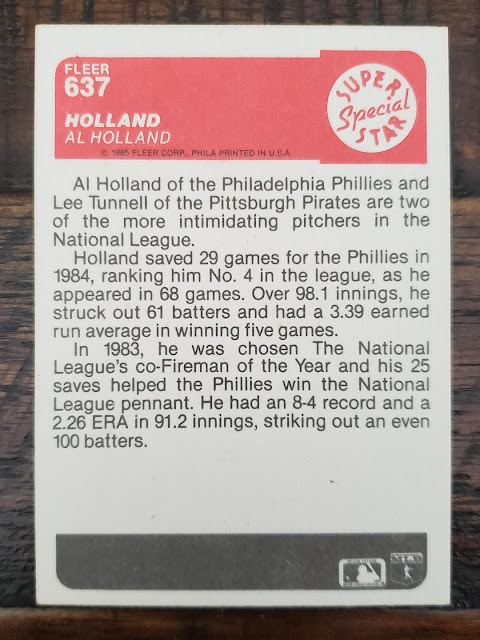I feel like I need just one more 1985 Fleer-related post before moving on to other hobby matters. Between this and the '85 Fleer Traded set, it's the only major set-completing I've done this year. It deserves at least two posts.
The 1985 Fleer set -- I think -- marks the end of a three-year Fleer experiment with cojoined cards. The very well-known and appreciated Super Star Specials that filled out the back of most '80s Fleer sets included cards that continued onto the next card in 1983, 1984 and 1985. (Maybe there are other later examples but my Fleer knowledge starts to fade after the '80s).
1985 contains the final two examples of these cards, starting with card numbers 635 and 636.
These are a whole lot of fun. But you need both cards in order to put them together like a puzzle and appreciate what you have in your collection. One card isn't going to do it.
By itself, it looks like an off-center card -- drastically off-center with no left border.
I would have loved to have been in the discussion room when this pairing was pitched. "We're giving the kids a geography lesson! Yeah, I know that's now how 'tunnel' is spelled, go with me on this!"
Al Holland did play for the Yankees at the very end of his career, but Tunnell never pitched for a New York team.
I can imagine kids who didn't collect Fleer in 1983 or 1984 being befuddled by these cards if they had pulled only one or the other. There is nothing on the back of the card that explains that these two cards are part of a pair. The Holland card does mention Lee Tunnell but it seems to come out of nowhere.
Perhaps Fleer figured it had run the gimmick for three years now, everyone should know.
It did give collectors a head's up in 1983 and 1984.
One thing '85 Fleer got absolutely right was orienting the cards so they paired up together on a 9-pocket page. This definitely did not happen in 1983 and 1984 as you'll see.
1984 Fleer had three cojoined examples. The first card is very straight-forward, mentioning that Carew and Boggs were the top two batting leaders for 1983.
The Raines-Oliver pairing throws an awful word play on Raines' name at you. You can see that the cards need to be cut right to pull of the effect evenly.
The Sax-Thon example is the first of these pairings in which I had both cards, the complete puzzle.
The back gives you an inset photo to clue you in that these cards are meant to form a card duo.
There you see the Raines and Oliver are side-by-side (and so are the Carew and Boggs on the preceding page). But the Sax and Thon are on different rows.
My first experience with these cards was in 1983. I didn't buy a lot of '83 Fleer, maybe enough to have around 200 cards. But one of the cards I pulled was the Reggie Jackson "Power" portion.
I wasn't a kid anymore in '83, I knew something was up. As you'll see in a minute, I had some help. The card sure did look weird by itself though.
Which one is better, "Holland Tunnell" or "Black & Blue"? I really like this one, it's my favorite.
Since it was Fleer's first try at this, it put as many explainers on the back as possible, a full photo of the two, mention on both that both 643 and 644 were needed and mentioning "Bud Black and Vida Blue" on each card, rather than each name separately like on later versions in '84 and '85.
But the page presentation is all off.
The card number order has the card on the left, in each case, following the card on the right. You could switch the Black and Blue to pull off the effect, but getting the Henderson and Jackson right is going to play some OCD havoc with the checklists.
There have been lots of examples of needing multiple cards to complete a full picture puzzle, both before and after the mid-1980s, but this was my first acquaintance with it.
Kinda cool, kinda weird. Just like Fleer.
















Comments
As I've gotten older I appreciate that Bud Black is on this Black and Blue pair as well as the 1991 Studio Black and Decker card. I also find myself wondering if you have the Dickie Thon card in your Dodgers binder. I probably would if there were a pair which included a Giant.